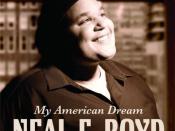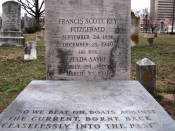The Great Gatsby
F. Scott Fitzgerald's use of language and symbolism forces readers to interpret different events in different ways, as well as think about what they have read. He builds his characters in a way which causes most readers to form similar opinions of them, creates complex relationships between the characters as well as uses descriptive language which forces us to construe events in our own way instead of simply listening to recounted proceedings. Fitzgerald's personal opinions on issues of the time also come into the novel, without disturbing the flow of the story. The Great Gatsby is not merely a recount of events, but also a rich source of language and symbolism with a clever development of characters and their relationships.
One of the most obvious and important parts of Fitzgerald's novel is his introduction of Nick, and ascertaining Nick's place as the just and trustworthy storyteller.
Fitzgerald deliberately creates an element of trust from the start of the novel through quoting Nick's father's advice, warning him against being judgmental; "Whenever you feel like criticizing anyone, just remember that all the people in the world haven't had the advantages you've had ". Nick then proceeds to say that he is now 'inclined to reserve all judgment', but that it can often be difficult and he questions his own honesty. Fitzgerald has also ensured that Nick is in several ways the 'middle man' of the book; he comes from a middle class background which is neither 'new' or 'old money'; he has an equilibrium of character which is neither the rough, blunt nature of Tom Buchanan or the more subtle and evasive nature of Gatsby; he is the listener of the book who attempts to find out all the facts before making judgement.
Another key aspect of F. Scott Fitzgerald's writing is his use of symbolism as an underlying meaning to the text. An example of this is can be seen when the description of the Valley of Ashes and the large face on a billboard. This description is making a statement about the religion of the twenties. Before the time in which The Great Gatsby is set, religion had always been a very important and impacting part of people's lives. The billboard is symbolising that God is watching; but instead of the ideas of the true God taught by the bible it is representing a materialistic God and the worship of money which came with the twenties. The American Dream brought this idea of money being everything. Another interesting feature of The Great Gatsby is the way event and places are described. The author has not merely recounted events, but has described things in terms of how they appear;
"...like that ashen, fantastic figure gliding toward him through the amorphous trees." This excerpt is describing the murder of Gatsby, and Fitzgerald's language has not only set the mood of the scene, but also given us a detailed description of how George Wilson approached Gatsby in the moments before he killed him. Another example of Fitzgerald's descriptive and flowing language can been seen in the portrayal of the Buchanan's estate.
"The lawn started at the beach and ran towards the front door for a quarter of a mile, jumping over sundials and brick walks and burning gardens"
This personification places in our minds a clear picture of the beautiful piece of land the Buchanans own.
The intricate relationships of the characters from The Great Gatsby are gradually exposed as the novel progresses, making characterisations essential. As narrator, Nick our window into the lives of these people, and it is his descriptions which allow us to form our opinions. We can see this through Nick's assessment of the Buchanan's and their lifestyle; his appraisal of Tom to be a hulking, gruff man with a 'cruel body '; his flowery description of Daisy who 'ballooned slowly to the floor ' as the wind died down. From these first words regarding the Buchanan's we regard them to be just as Nick described; Tom to be a harsh and unforgiving man while Daisy is a soft, fairylike yet vulnerable woman. Their relationship at first seems to be very unloving and artificial, but we discover later in the novel that in fact Tom does care about Daisy more than he originally allowed us to see. The Valley of Ashes is also an important setting of the novel, and the depiction of this district is crucial to understand the lives of the people living in it. This idea can be seen in the portrayal of George Wilson when the vocabulary associated with him can also be associated with the Valley. Burnt out, grey and a failed American Dream.
Language, symbolism, and the development of relationships and characters are a vital part of the novel. Fitzgerald has woven his own opinions into the storyline and made comments on the issues of the time. The ever present allusion to the American Dream forces one to question if it is really something worth striving for, as although it represents the idea of working and achieving anything, regardless of what you started with, it does not always bring happiness as in Gatsby's case. It is important to construe events in this novel in our own way, as Fitzgerald describes how things appear rather that the actual event itself. The Great Gatsby contains a number of aspects which combine to create a complex tale of relationships and the American Dream.


